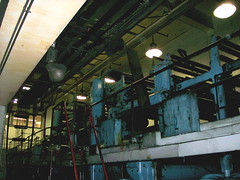 I returned home to Colorado last night to hear that the Rocky Mountain News was publishing their final edition today -- some of the employees were absorbed into the Denver Post and most others were simply laid off. In watching some of the television coverage there seemed to be varying degrees of shock among employees and older subscribers; there did not seem to be any shock among younger people interviewed.
I returned home to Colorado last night to hear that the Rocky Mountain News was publishing their final edition today -- some of the employees were absorbed into the Denver Post and most others were simply laid off. In watching some of the television coverage there seemed to be varying degrees of shock among employees and older subscribers; there did not seem to be any shock among younger people interviewed.Early this morning I saw a story about how the San Francisco Chronicle may have to shut down because it is hemorrhaging money. In San Francisco, unlike in Denver, there is only the Chronicle, so a closure of the Chronicle means that the daily newspaper goes away.
This morning I saw an announcement Hearst Corporation is going to launch its own e-reader for the distribution of magazines and newspapers. Interesting timing to be sure, although probably fairly coincidental as it relates to the Rocky Mountain News, though Hearst is the parent corporation of the San Francisco Chronicle, so perhaps not so coincidental at all.
I attended a conference last week at which there was a panel of persons representing various media outlets, including newspapers. The newspaper representatives at the conference said that they were exploring strategies including a more heavily scaled focus on their website, the ability for citizens to post blogs and/or articles on the main newspaper site, and printing micro, tightly regionalized papers that included articles written by people living within those regional areas (i.e., non-professional writers).
A few weeks ago I was explaining to a good friend that I consume my news via the reading of blogs and that although I saw most of the same news that he did, I reached the news outlets by different ways (if I ever even reached them at all). Generally by consuming news through blogs, I get 2 or more opinions of a news story and don't necessarily need to see the (supposedly) unbiased reporting from a news outlet.
It's my opinion that news companies are confusing their vector (print vs. e-reader) with an underlying issue of a fundamental shift in the way that their content is consumed. Hearst is trying to create a device that allows for dynamic advertising while still providing the same content -- could you imagine the amount of ads in a Cosmopolitan magazine (Hearst owns it and I'm secure enough to admit I've looked through one) on a single page e-book reader with no color? Just the thought of that is extraordinarily painful. However, I suppose that if you are one of those consumers that is used to holding the newspaper artifact in your hand as part of the ritual of reading and newspapers are severely cutting or eliminating printing, then perhaps Hearst has exactly what you need.
What do you think?
Picture from Jon B. Swerens
1 comment:
It's all bizarre really. A 2007 TMP poll showed 77% of those who read local newspapers trusted the adverts more than any they saw on TV or online ...
It's definitely about Adsens-style issues and not being confined to a finite space in print.
Post a Comment